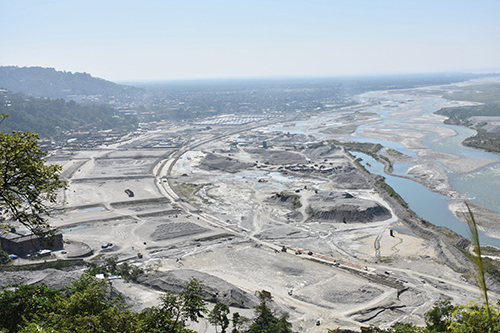By Sonam Chuki
Copyright thebhutanese

Phuentsholing Township Development Project (PTDP), one of the country’s largest urban initiatives, is set to reshape the country’s commercial hub with a modern township designed to ease housing shortages, reduce congestion, and protect the town from flooding risks.
Spread over 160 acres of reclaimed riparian land, the project is introducing world-class urban infrastructure guided by smart city principles.
The project was initially envisaged to protect the existing Phuentsholing town from major floods and to ease the demand for development space. In addition, more than 100 acres of private land in the Amochhu area have been made habitable by flood protection works and are being developed under a Local Area Plan by Phuentsholing Thromde. With zones for housing, business, industry, and tourism, supported by reliable infrastructure, the township is expected to make Phuentsholing more livable while reinforcing its role as Bhutan’s main trading and commercial hub.
Residents can expect significant improvements in infrastructure once the project is completed. Around six kilometers of new concrete roads will be developed with landscaping, streetlights, footpaths, tactile flooring, and accessibility ramps. The road network will include an 18-meter-wide primary road and secondary roads measuring 12 meters and 9 meters. These will house essential utilities such as stormwater drainage, electrical lines, telecommunications, and sewerage chambers.
Water and sanitation facilities include a treatment plant with a capacity of 3 million liters per day (MLD), reservoirs, and a complete distribution network, managed through an automated SCADA monitoring system. Wastewater will be handled by a sewage treatment plant using SBR technology with a 6 MLD capacity, which will also treat the existing Thromde’s sewage.
Flood protection works, including erosion-resilient diaphragm walls and reclaimed land raised above flood levels, have been completed. Promenades designed as public spaces double as flood defenses with permeable walkways that allow water to filter through during both normal and flood conditions. Utilities such as power distribution networks, ICT infrastructure, and a flood early warning system are also part of the development.
The project further introduces a solid waste resource recovery facility (SWTY) to replace existing landfill practices. Waste will be segregated, composted, and recycled, with a 30-ton electronic weighbridge installed for record keeping. The facility is designed to serve both the new township and existing Phuentsholing, reducing landfill pressure and promoting sustainable waste management.
Community amenities form another central aspect of the township, with 9.28 acres allocated for green spaces, recreational parks, leisure zones, cafés, convenience stores, and parking facilities. IT systems will support efficient management. Developed plots will be leased to private developers under PTDP guidelines, which encourage the adoption of smart technologies and green building incentives.
Phuentsholing has faced chronic challenges of flooding, congestion, and limited space for expansion. The PTDP’s 4.5-kilometer embankment along the left bank of the Amochhu River is designed to withstand a one-in-one-hundred-year flood estimated at 7,000 cumecs. The largest flood on record in 2016 measured 2,500 cumecs. Since the embankments were built, no flooding has been reported for three consecutive monsoons.
The township also creates new space for housing and urban development. Open spaces, including a 30-meter riverfront zone, will enhance livability, while public and private parking facilities and international-standard road widths are expected to ease traffic congestion.
Economically, the township will offer about 80 acres of leasable land to investors and developers. It is planned as a mixed-use city, with zones for hotels, commercial and trading centers, residential areas, and small- and medium-scale green industries.
In terms of social impact, the township is expected to ease housing shortages while accommodating schools, health facilities, and public offices. Less than half of the total land will be developed, with the remainder set aside for urban utilities and public spaces. Properly planned green areas, safe roads, and modern sanitation systems are designed to make life more convenient and healthier, while also offering residents and children of the existing town access to a better quality of life.
The development is aligned with the Phuentsholing Structure Plan (2013–2028) and makes use of reclaimed land, thereby minimizing displacement of communities or small businesses. PTDP is also working with Phuentsholing Thromde to coordinate water supply and sewage treatment systems, ensuring that the project complements and enhances the existing urban fabric.
Climate resilience is embedded into the township’s design. Flood protection structures, raised land levels, and a flood early warning system are integrated with drainage, water, and waste systems built to withstand extreme weather. Green planning principles, including walkability, greenery, and open spaces, further enhance environmental sustainability.
By combining flood protection, climate-resilient infrastructure, and modern urban amenities, the Phuentsholing Township Development Project is set to safeguard both residents and economic activities, positioning the commercial hub for a new phase of growth and security.



